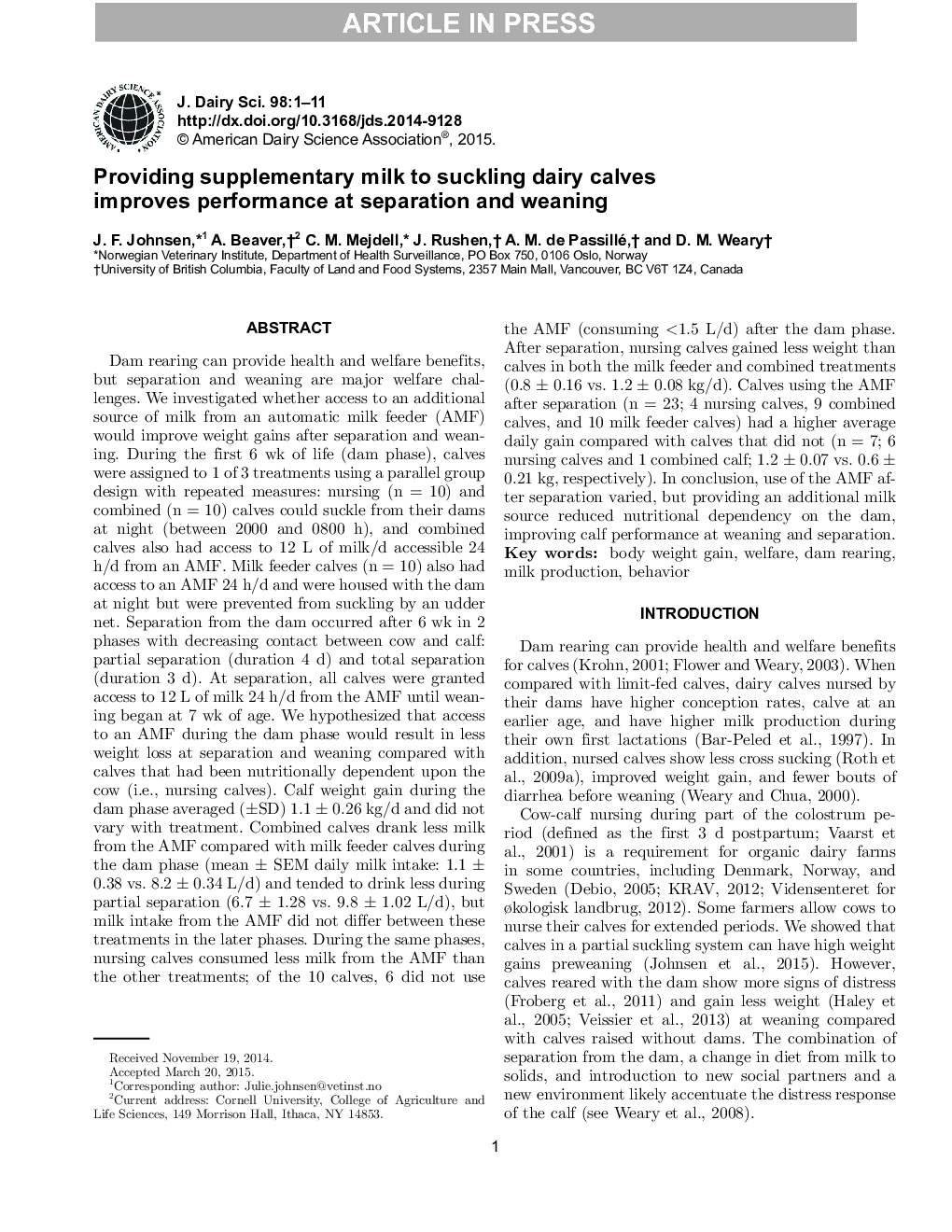| کد مقاله | کد نشریه | سال انتشار | مقاله انگلیسی | نسخه تمام متن |
|---|---|---|---|---|
| 10975309 | 1108032 | 2015 | 11 صفحه PDF | دانلود رایگان |
عنوان انگلیسی مقاله ISI
Providing supplementary milk to suckling dairy calves improves performance at separation and weaning
ترجمه فارسی عنوان
ارائه شیرهای اضافی برای شیردهی شیرخواران عملکرد در جداسازی و شیردهی را بهبود می بخشد
دانلود مقاله + سفارش ترجمه
دانلود مقاله ISI انگلیسی
رایگان برای ایرانیان
کلمات کلیدی
افزایش وزن بدن، رفاه، پرورش سد، تولید شیر، رفتار - اخلاق،
موضوعات مرتبط
علوم زیستی و بیوفناوری
علوم کشاورزی و بیولوژیک
علوم دامی و جانورشناسی
چکیده انگلیسی
Dam rearing can provide health and welfare benefits, but separation and weaning are major welfare challenges. We investigated whether access to an additional source of milk from an automatic milk feeder (AMF) would improve weight gains after separation and weaning. During the first 6 wk of life (dam phase), calves were assigned to 1 of 3 treatments using a parallel group design with repeated measures: nursing (n = 10) and combined (n = 10) calves could suckle from their dams at night (between 2000 and 0800 h), and combined calves also had access to 12 L of milk/d accessible 24 h/d from an AMF. Milk feeder calves (n = 10) also had access to an AMF 24 h/d and were housed with the dam at night but were prevented from suckling by an udder net. Separation from the dam occurred after 6 wk in 2 phases with decreasing contact between cow and calf: partial separation (duration 4 d) and total separation (duration 3 d). At separation, all calves were granted access to 12 L of milk 24 h/d from the AMF until weaning began at 7 wk of age. We hypothesized that access to an AMF during the dam phase would result in less weight loss at separation and weaning compared with calves that had been nutritionally dependent upon the cow (i.e., nursing calves). Calf weight gain during the dam phase averaged (±SD) 1.1 ± 0.26 kg/d and did not vary with treatment. Combined calves drank less milk from the AMF compared with milk feeder calves during the dam phase (mean ± SEM daily milk intake: 1.1 ± 0.38 vs. 8.2 ± 0.34 L/d) and tended to drink less during partial separation (6.7 ± 1.28 vs. 9.8 ± 1.02 L/d), but milk intake from the AMF did not differ between these treatments in the later phases. During the same phases, nursing calves consumed less milk from the AMF than the other treatments; of the 10 calves, 6 did not use the AMF (consuming <1.5 L/d) after the dam phase. After separation, nursing calves gained less weight than calves in both the milk feeder and combined treatments (0.8 ± 0.16 vs. 1.2 ± 0.08 kg/d). Calves using the AMF after separation (n = 23; 4 nursing calves, 9 combined calves, and 10 milk feeder calves) had a higher average daily gain compared with calves that did not (n = 7; 6 nursing calves and 1 combined calf; 1.2 ± 0.07 vs. 0.6 ± 0.21 kg, respectively). In conclusion, use of the AMF after separation varied, but providing an additional milk source reduced nutritional dependency on the dam, improving calf performance at weaning and separation.
ناشر
Database: Elsevier - ScienceDirect (ساینس دایرکت)
Journal: Journal of Dairy Science - Volume 98, Issue 7, July 2015, Pages 4800-4810
Journal: Journal of Dairy Science - Volume 98, Issue 7, July 2015, Pages 4800-4810
نویسندگان
J.F. Johnsen, A. Beaver, C.M. Mejdell, J. Rushen, A.M. de Passillé, D.M. Weary,
